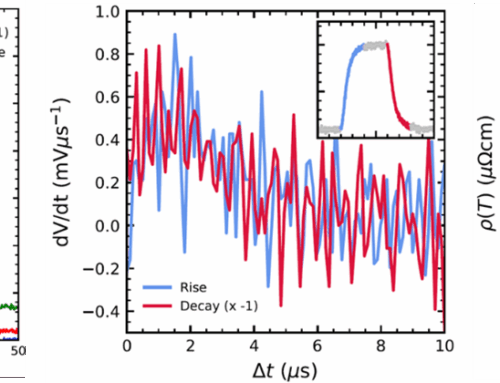Frank Stefani und Thomas Herrmannsdörfer, HZDR and HLD Dresden.
The heating of the Sun‘s corona to temperatures of several million kelvin is one of the major unsolved problems of solar physics. Although magnetic fields are unambiguously considered responsible for the “pot being hotter than the stove”, it remains controversial whether the very heating mechanism is due to sudden reconnections of magnetic field lines or to the dampening of different types of waves in the solar plasma. A particularly important region in this respect is the so-called magnetic canopy below the corona, where sound and Alfvén waves have roughly the same speed and, therefore, can easily transform into each other. Yet, this “magic point” had remained inaccessible to experimenters until now: While in plasma experiments the Alfvén speed is typically much higher than the speed of sound, in all liquid-metal experiments to date it has been significantly lower. The reason for this was the limitation of available static magnetic fields, which do not produce sufficient magnetic tension for the Alfvén waves to travel with the same high speed as the sound. The main idea of our experiment was to utilize the pulsed magnetic fields available at HLD to allow Alfvén waves to cross the “sound barrier”, which appears at a reachable value of 54 T when using liquid rubidium. Due to the high chemical reactivity of this alkali metal, it had to be filled (in a glove box) into a sturdy stainless-steel container of 10 mm inner radius and 60 mm height (see the inset of Figure a). By injecting an alternating current at the bottom of the container and exposing it to the pulsed magnetic field of up to 63 T (Figure a), it was finally possible to generate Alfvén waves in the melt, whose upward motion had the expected speed, just as in many previous experiments. The novel result was that, while the frequency of the alternating current signal dominates all measurements up to the “magic point” of 54 T, exactly at this point a new signal with halved frequency appeared (insets of Figure b). This sudden period doubling is in perfect agreement with the theoretical predictions of a parametric resonance as described by Zaqarashvili and Roberts in 2006. Although we cannot yet explain all observed effects so easily, our work sheds light on an important mechanism related the Sun‘s corona heating. For the future, we are planning detailed numerical analyses of our results and further experiments.

Figure: (a) Time dependence of the pulsed magnetic field and (b) of the voltage measurements at the lower contact. The red dashed lines indicate the instants where the critical field strength of 54 T is crossed. The two inset pictures in (a) show the stainless steel container filled with rubidium, and the holder with pick-up and compensation coils. The insets in (b) detail the two transition regions, where the double-period signal due to torsional Alfvén wave starts and ceases to exist.
Mode Conversion and Period Doubling in a Liquid Rubidium Alfvén-Wave Experiment with Coinciding Sound and Alfvén Speeds, F. Stefani, J. Forbriger, Th. Gundrum, T. Herrmannsdörfer, and J. Wosnitza, Phys. Rev. Lett. 127, 275001 (2021). https://journals.aps.org/prl/abstract/10.1103/PhysRevLett.127.275001
Contact: f.stefani@hzdr.de , t.herrmannsdoerfer@hzdr.de






